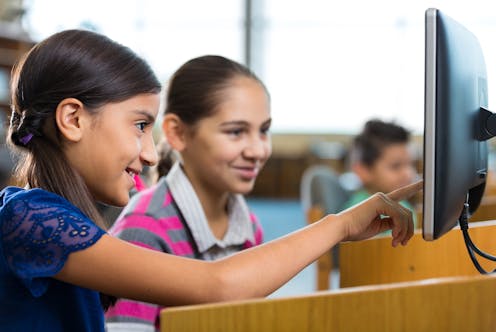'Time warp' takes students to Native American past to search for solutions for the future
- Written by Eric M. Anderman, Professor of Educational Psychology and Quantitative Research, Evaluation, and Measurement, The Ohio State University

The eyes of the fifth graders in Ms. Evans’ class widened as they saw a dazzling light on the classroom smartboard and the phrase, “Let’s do the Time Warp!”
Ms. Evans, who teaches at a large suburban school in central Ohio, told her students that they were about to take a trip to a Native American community as it existed in the 19th century.
“We are now traveling back in time to Florida in the 1800s to visit a village of the Seminole,” Ms. Evans told her class excitedly as she began to read aloud the story of Seminole leader Osceola[1].
In the story, Osceola says, “The white man wants our groves of orange trees, our fine harbors, our full forests, and warm fertile lands. But they are ours. Here are our fish and birds and animals, the graves of our fathers, the grounds of our children.”
Immediately, a beautiful village appears on their Chromebooks. The students are welcomed by the Seminole before they engage with a series of interactive slides. They are introduced to the foods the Seminole eat, the clothes they wear and their daily experiences. They are invited to stay and live with the Seminole while they visit. However, on this first day of the history unit, students do not yet know that soon Osceola will face captivity by U.S. troops, who trick him into meeting for a truce.
The experience exemplifies the kinds of social studies lessons that our research group – Digital Civic Learning[2] – has been developing since 2020 to enable students to use immersive storytelling[3] to better understand different perspectives on complex historical issues, as well as current social ones. We’ve been working with elementary school teachers from several school districts in Ohio.
Overcoming a narrow view of history
Whereas other curricula may emphasize memorization of facts and dates[4], our approach emphasizes dialogue among students to make learning history more exciting.
In our view[5] as educational psychologists[6], the need for such an approach is made clear by national data, which shows that American teenagers’ knowledge of U.S. history[7] has been declining for the past decade[8].
Some of the history curricula currently used in schools are rooted in settler colonialism[9], which focuses on the displacement of Indigenous populations[10] with new settlers, and often minimizes the perspectives of underrepresented populations.
Our approach integrates technology, immersive learning – such as an up-close look at the daily lives of the Seminole – and collaborative small-group discussions into daily social studies instruction.
The interactive experiences that students have with the Seminole were created using Google Slides[11]. The slides consist of illustrations, story narrations, easy-to-read texts and interactive activities developed by our team. Beyond history, we also created units in geography, government and economics. Each unit was designed for upper elementary school students and delivered to students over two weeks.
Discussing dilemmas
Students actively participate in small-group discussions[12] on the third and ninth day of each unit.
In our Seminole example, students are asked to reflect on the Treaty of Payne’s Landing[13], signed in 1832. The treaty required the Seminole to give up their land in Florida in exchange for new land in the West.
They discuss the dilemma that Osceola faced when deciding whether to accept the treaty in order to maintain peace, or to refuse to agree to the new treaty so that the Seminole could stay on their land.
Our approach to teaching history also emphasizes connections with current events, such as the Dakota Access Pipeline[14]. The construction of the pipeline will help the economy by creating jobs and making the U.S. less dependent on foreign oil. However, the pipeline will be built on land owned by Native Americans who are deeply concerned that the pipeline will lead to contamination of groundwater and soil[15].
Students learn about a related situation in which the federal government has been debating whether to approve the construction of another pipeline in Minnesota[16] that would go directly through Native American land. Working in groups, students come up with reasons for being either for or against the construction of the pipeline.
Based on our analysis of student discussions and essays over the course of this unit[17], we’ve found that through these immersive learning and interactive practices, students work more collaboratively and are more likely to consider multiple perspectives in civic debates.
Surveys also found that students who participated in the curriculum became more emotionally engaged with learning history[18] – in part by making emotional connections with story characters – as they developed a deeper understanding of how historical events affect people’s lives.
References
- ^ Osceola (www.tribalnationsmaps.com)
- ^ Digital Civic Learning (digitalciviclearning.com)
- ^ use immersive storytelling (doi.org)
- ^ memorization of facts and dates (woodrow.org)
- ^ our view (scholar.google.com)
- ^ educational psychologists (scholar.google.com)
- ^ knowledge of U.S. history (www.nationsreportcard.gov)
- ^ declining for the past decade (www.nationsreportcard.gov)
- ^ settler colonialism (eric.ed.gov)
- ^ displacement of Indigenous populations (www.law.cornell.edu)
- ^ Google Slides (www.wikihow.com)
- ^ small-group discussions (bpspsychub.onlinelibrary.wiley.com)
- ^ Treaty of Payne’s Landing (dos.fl.gov)
- ^ Dakota Access Pipeline (daplpipelinefacts.com)
- ^ groundwater and soil (americanindian.si.edu)
- ^ another pipeline in Minnesota (www.pbs.org)
- ^ analysis of student discussions and essays over the course of this unit (www.proquest.com)
- ^ more emotionally engaged with learning history (aera22-aera.ipostersessions.com)
Authors: Eric M. Anderman, Professor of Educational Psychology and Quantitative Research, Evaluation, and Measurement, The Ohio State University


